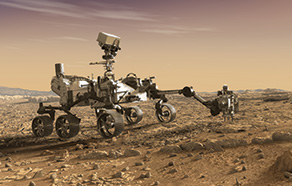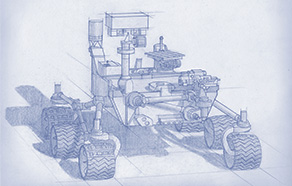


 Mars 2020 NASA Homepage
Mars 2020 Mission Overview
Mars 2020 Rover
Ask NASA Mars! ROV-E
NASA Begins Building its Next Rover
Mars 2020 Target: Jezero Crater
NASA Missions A-Z
Informal Educator Worksheet
Formal Educator Worksheet
Mars 2020 NASA Homepage
Mars 2020 Mission Overview
Mars 2020 Rover
Ask NASA Mars! ROV-E
NASA Begins Building its Next Rover
Mars 2020 Target: Jezero Crater
NASA Missions A-Z
Informal Educator Worksheet
Formal Educator Worksheet
 Mission to Mars Unit
Explore: Life on Mars
Astrobio Bound
Robotic Arm Challenge
Mission to the Red Planet
Planetary Pasta Rovers
Roving on the Moon
Rover Races
Design Exploration Vehicles
The Air up There
Exploration Mars with NASA
NGSS Mars Lessons
Materials from Mystery Planet
Astrobiology NASA Resources
Looking for Life
Mission to Mars Unit
Explore: Life on Mars
Astrobio Bound
Robotic Arm Challenge
Mission to the Red Planet
Planetary Pasta Rovers
Roving on the Moon
Rover Races
Design Exploration Vehicles
The Air up There
Exploration Mars with NASA
NGSS Mars Lessons
Materials from Mystery Planet
Astrobiology NASA Resources
Looking for Life
The Mars 2020 mission will not only seek signs that Mars could have supported life in the ancient past, but will also search for signs of past microbial (single-cell) life itself. The Mars 2020 rover has a drill that can collect core samples of the most promising rocks and soils in special tubes, and set them aside in a "cache" on the surface of Mars. A future mission could bring these samples back to Earth. That would help scientists study the samples in laboratories with equipment that would be too large to take to Mars. What are the mission’s science goals and how will the rover help achieve these goals?
The Mars 2020 mission will not only seek signs that Mars could have supported life in the ancient past, but will also search for signs of past microbial (single-cell) life itself. The Mars 2020 rover has a drill that can collect core samples of the most promising rocks and soils in special tubes, and set them aside in a "cache" on the surface of Mars. A future mission could bring these samples back to Earth. That would help scientists study the samples in laboratories with equipment that would be too large to take to Mars. What are the mission’s science goals and how will the rover help achieve these goals?
The six-wheeled rover has a “rocker-bogie” suspension system, to help it stay balanced while cruising over rocky Martian terrain. Each wheel has its own individual motor and the two in front and in the back have steering motors with a 360-degree capability. The rover itself is the size of a small SUV (10 feet long, not including the arm) with a top speed of 1.5 inches per second which is about one-tenth of a mile per hour. How does the “rocker-bogie” system keep the rover from tipping over? How does the 360-degree steering help the rover move around?
Getting information to and from the Rover is vital to the mission. It takes about 5 to 20 minutes for a radio signal to travel between Mars and Earth. The rover is equipped with three antennas that serve as both its “voice” and “ears”. What are these antennas for and how will they relay messages to the Earth and back to Mars?
The rover has several cameras focused on engineering and science tasks. Some help the rover land on Mars, while others serve as the rover’s “eyes” on the surface to drive around. Scientists will use others to do scientific observations to help decide which rock and soil samples to collect. The rover has a total of 23 cameras, some of which can even take video! What do the cameras do and are they so important to the rover?
The rover has several cameras focused on engineering and science tasks. Some help the rover land on Mars, while others serve as the rover’s “eyes” on the surface to drive around. Scientists will use others to do scientific observations to help decide which rock and soil samples to collect. The rover has a total of 23 cameras, some of which can even take video! What do the cameras do and are they so important to the rover?
The Mars 2020 "Name the Rover" Challenge is presented by challenge partners: NASA, Future Engineers, and Battelle Education. Additional prizes arranged by Future Engineers through Amazon Web Services. The student contest is part of NASA's efforts to engage the public in its missions to the Moon and Mars. The currently unnamed rover is a robotic scientist weighing more than 2,300 pounds (1,000 kilograms). It will search for signs of past microbial life, characterize the planet's climate and geology, collect samples for future return to Earth, and pave the way for human exploration of the Red Planet. The spacecraft is targeted for a July 2020 launch and is expected to touch down on Mars in February 2021.
Thank you for your interest in contacting Future Engineers. We look forward to connecting with you!
General Inquiries
support@futureengineers.orgSponsorship Inquiries
sponsor@futureengineers.org